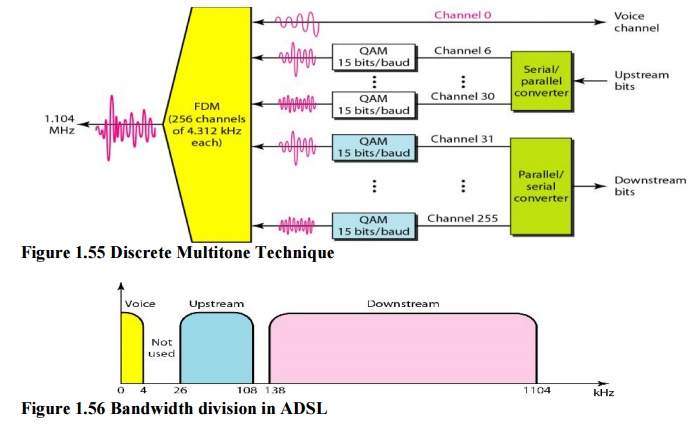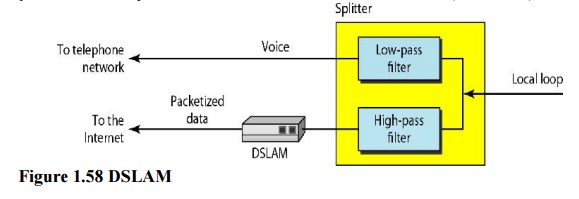Chapter: Computer Networks : Physical Layer
Digital Subscriber Line
Digital Subscriber Line:
Digital
subscriber line (DSL) technology is one of the most promising for supporting
high-speed digital communication over the existing local loops.
1. ADSL
ADSL,
like a 56K modem, provides higher speed (bit rate) in the downstream direction
(from the Internet to the resident) than in the upstream direction (from the
resident to the Internet). That is the reason it is called asymmetric.
Discrete
Multitone Technique
The
modulation technique that has become standard for ADSL is called the discrete
multitone technique (DMT) which combines QAM and FDM. There is no set way that
the bandwidth of a system is divided. Each system can decide on its bandwidth
division. Typically, an available bandwidth of 1.104 MHz is divided into 256
channels. Each channel uses a bandwidth of 4.312 kHz.

Figure
1.56 shows how the bandwidth can be divided into the following:
·
Voice. Channel
0 is reserved for voice communication.
·
Idle.
Channels 1 to 5 are not used and provide a gap between voice and
datacommunication.
·
Upstream
data and control. Channels 6 to 30 (25 channels) are used for upstream
datatransfer and control. One channel is for control, and 24 channels are for
data transfer.
·
Downstream
data and control. Channels 31 to 255 (225 channels) are used
fordownstream data transfer and control. One channel is for control, and 224
channels are for data.
Customer
Site: ADSL Modem
An ADSL
modem installed at a customer's site. The local loop connects to a splitter
which separates voice and data communications. The ADSL modem modulates and
demodulates the data, using DMT, and creates downstream and upstream channels.

Telephone
Company Site: DSLAM
At the
telephone company site, the situation is different. Instead of an ADSL modem, a
device called a digital subscriber line access multiplexer (DSLAM) is installed
that functions similarly. In addition, it packetizes the data to be sent to the
Internet (ISP server).

2. ADSL Lite
The
installation of splitters at the border of the premises and the new wiring for
the data line can be expensive and impractical enough to dissuade most subscribers.
A new version of ADSL technology called ADSL Lite (or Universal ADSL or
splitterless ADSL) is available for these subscribers.
3. HDSL
The
high-bit-rate digital subscriber line (HDSL) was designed as an alternative to
the T-l line (1.544 Mbps). The T-1line uses alternate mark inversion (AMI)
encoding, which is very susceptible to attenuation at high frequencies. This
limits the length of a T-l line to 3200 ft (1 km). For longer distances, a
repeater is necessary, which means increased costs.
4. SDSL
The
symmetric digital subscriber line (SDSL) is a one twisted-pair version of HDSL.
It provides full-duplex symmetric communication supporting up to 768 kbps in
each direction. SDSL, which provides symmetric communication, can be considered
an alternative to ADSL.
5. VDSL
The very
high-bit-rate digital subscriber line (VDSL), an alternative approach that is
similar to ADSL, uses coaxial, fiber-optic, or twisted-pair cable for short
distances. The modulating technique is DMT. It provides a range of bit rates
(25 to 55 Mbps) for upstream communication at distances of 3000 to 10,000 ft.
The downstream rate is normally 3.2 Mbps.
Related Topics